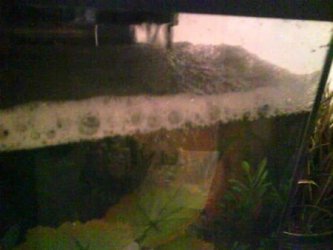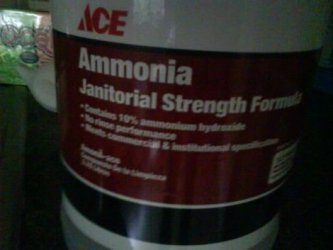waterdrop
Enthusiastic "Re-Beginner"
Don't forget that there can be significant activity in both ammonia and nitrite(NO2) at the levels below "zero" (our crude test kits just give us something we take to be "zero ppm" at some point where they no longer have the sensitivity to detect enough of the substance (ammonia or nitrite) to cause a reaction that results in color. This doesn't mean that there is not "substance." Does that make sense?
Another way to think about this is as follows: Think about a mature biofilter (say your sponge sitting there with A-Bacs and N-Bacs stained all over the little surfaces of the sponge material) and a healthy population of fish now populating the tank. What is happening? The fish are putting out perhaps 2 or 3ppm of ammonia and yet since you now have a working biofilter, you are always measuring zero ppm ammonia and zero ppm nitrite, right? A healthy flow -below- the "zero" level is going on: ammonia is getting processed by the A-Bacs in to nitrite(NO2) and before your test can detect any, the N-Bacs are processing the nitrite(NO2) into nitrate(NO3) and so you know in theory that nitrate(NO3) is slowly rising in the tank water (unfortunately, our NO3 tests are so insensitive and sometimes downright "whacky" that we rarly get to really have a way to see that little slowly rising bit. What a shame!)
My point is to answer the question you asked in boldface: Yes, now that you are seeing a little bit of drop in the ammonia you added, you can assume that yes, the N-Bacs are beginning to process a little bit of nitrite(NO2) into nitrate(NO3) but that it is just not enough to leave any EXCESS nitrite(NO2) that would give you some purple color instead of the blue you've been seeing for so long. And yes, patience is truly the biggest problem by far that we all deal with here, lol.
As OM47 mentions, soon your A-Bacs will be pumping out so much NO2 that there will be an excess and you will finally begin to see or almost immediately experience your nitrite spike (unless the seeded sponge has so many N-Bacs that it processes it on through to NO3 right from the start.) I see that you have actually found a business which advertises that it is simply putting sponge filters in tanks of fish and then shipping you a mature media (MM) sponge. This should be great - this is what you are getting when you get an MM donation from another member of the forum here and it can be a significant help to a first cycle.
Are you planning to leave the little 3-inch sponge block filter inside your 12G forever? I ask because if not, then your real goal is to cycle your -main- filter. The mature sponge you've purchased will begin to give you feedback that you're cycling the tank but that feedback will be more indicative of what the new sponge is doing, not necessarily the main biowheel filter. The autotrophic bacteria do not migrate easily between filters. People often want to put a mature filter on a new tank and hope that the mature filter will "seed" the new filter. This can take up to 6 months sometimes!
In your case, if you want to eventually get rid of the sponge block filter and run only with the less-visible HOB filter, you will want to probably use scissors to slice up the block filter and put little sponge strips into the pouches of the "panels" in the biowheel filter (I think they usually have little sacks on plastic frames in the box below the biowheel, right? These biowheel filters are among the types of filters where the design is focused on trying to sell you replacement media on a regular basis, which is not something that is desirable to experienced hobbyists, unfortunately. But often one of the sacks is filled with carbon and can be replaced with the strips of mature sponge you have (carbon is basically useless after 3 days in the tank, which is why hobbyists rarely use it on a regular basis.)
Now don't get me wrong. In your case, even if you're planning to eventually get rid of the sponge block, I'd still proceed to "cycle" the tank with the sponge intact as it currently is. You want to be sure the bacteria you've received are allowed to survive and grow after the disturbance of being moved (99% of the time bacteria moves just fine!) I would still wait a good long time before doing the sort of scissors procedure I've described above. (not to mention that it is sheer speculation on my part as perhaps you plan to keep the sponge filter intact or use it for your quarantine tank or such.)
~~waterdrop~~
Another way to think about this is as follows: Think about a mature biofilter (say your sponge sitting there with A-Bacs and N-Bacs stained all over the little surfaces of the sponge material) and a healthy population of fish now populating the tank. What is happening? The fish are putting out perhaps 2 or 3ppm of ammonia and yet since you now have a working biofilter, you are always measuring zero ppm ammonia and zero ppm nitrite, right? A healthy flow -below- the "zero" level is going on: ammonia is getting processed by the A-Bacs in to nitrite(NO2) and before your test can detect any, the N-Bacs are processing the nitrite(NO2) into nitrate(NO3) and so you know in theory that nitrate(NO3) is slowly rising in the tank water (unfortunately, our NO3 tests are so insensitive and sometimes downright "whacky" that we rarly get to really have a way to see that little slowly rising bit. What a shame!)
My point is to answer the question you asked in boldface: Yes, now that you are seeing a little bit of drop in the ammonia you added, you can assume that yes, the N-Bacs are beginning to process a little bit of nitrite(NO2) into nitrate(NO3) but that it is just not enough to leave any EXCESS nitrite(NO2) that would give you some purple color instead of the blue you've been seeing for so long. And yes, patience is truly the biggest problem by far that we all deal with here, lol.
As OM47 mentions, soon your A-Bacs will be pumping out so much NO2 that there will be an excess and you will finally begin to see or almost immediately experience your nitrite spike (unless the seeded sponge has so many N-Bacs that it processes it on through to NO3 right from the start.) I see that you have actually found a business which advertises that it is simply putting sponge filters in tanks of fish and then shipping you a mature media (MM) sponge. This should be great - this is what you are getting when you get an MM donation from another member of the forum here and it can be a significant help to a first cycle.
Are you planning to leave the little 3-inch sponge block filter inside your 12G forever? I ask because if not, then your real goal is to cycle your -main- filter. The mature sponge you've purchased will begin to give you feedback that you're cycling the tank but that feedback will be more indicative of what the new sponge is doing, not necessarily the main biowheel filter. The autotrophic bacteria do not migrate easily between filters. People often want to put a mature filter on a new tank and hope that the mature filter will "seed" the new filter. This can take up to 6 months sometimes!
In your case, if you want to eventually get rid of the sponge block filter and run only with the less-visible HOB filter, you will want to probably use scissors to slice up the block filter and put little sponge strips into the pouches of the "panels" in the biowheel filter (I think they usually have little sacks on plastic frames in the box below the biowheel, right? These biowheel filters are among the types of filters where the design is focused on trying to sell you replacement media on a regular basis, which is not something that is desirable to experienced hobbyists, unfortunately. But often one of the sacks is filled with carbon and can be replaced with the strips of mature sponge you have (carbon is basically useless after 3 days in the tank, which is why hobbyists rarely use it on a regular basis.)
Now don't get me wrong. In your case, even if you're planning to eventually get rid of the sponge block, I'd still proceed to "cycle" the tank with the sponge intact as it currently is. You want to be sure the bacteria you've received are allowed to survive and grow after the disturbance of being moved (99% of the time bacteria moves just fine!) I would still wait a good long time before doing the sort of scissors procedure I've described above. (not to mention that it is sheer speculation on my part as perhaps you plan to keep the sponge filter intact or use it for your quarantine tank or such.)
~~waterdrop~~














